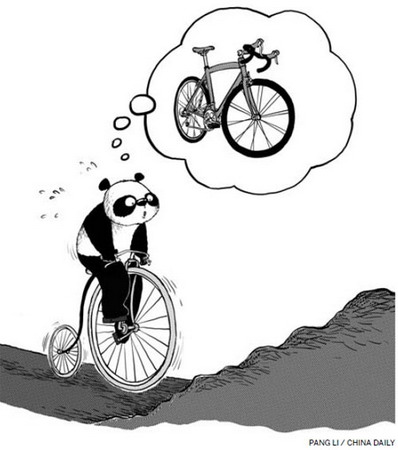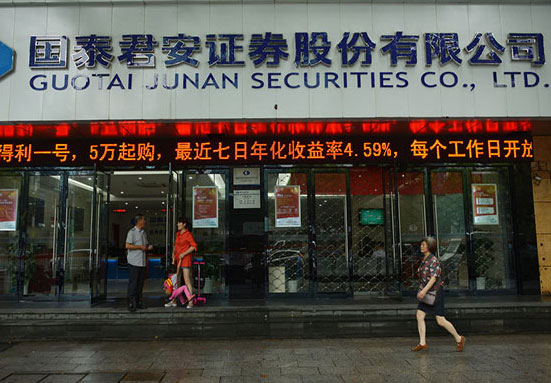

|
 |
Should the Chinese authorities launch another economic stimulus program, in light of a slowing domestic economy and volatile financial, economic and social conditions in Europe and elsewhere? My answer is "yes", but in a way that promotes long-term growth with fewer bubbles and less inequality. To this end, the following mutually-reinforcing and complementary policy adjustments are recommended.
First, we need a more aggressive lowering of the reserve requirement ratio for banks than has happened so far. This would provide enough liquidity and credit for private enterprises while keeping interest rates in the unofficial markets at lower levels that are less punishing for smaller players in the real economy.
Second, when lowering the reserve requirement ratio, the central bank should also consider raising deposit rates aggressively over a period of time, so that they align more closely with the estimated medium and long-term inflation rate. Inevitably, such a change would drive up the cost of borrowing for State-owned enterprises and local government projects. But the increased lending rate would still be much lower than the interest rates charged in unofficial credit markets, such as those in Wenzhou. This would bring relief to the private sector and stimulate borrowing for small business growth.
In China's particular context, raising interest rates in the formal banking system is not intended to slow economic growth. Rather, it takes aim at entrenched inflation stemming from deeper structural problems and imbalances in China's economy which left unaddressed will continue for decades more.
These structural problems include over-capacity and excessive supply in sectors such as infrastructure, which can be traced back to debt rapidly taken on by State-owned enterprises and local governments. Higher interest rates would bolster market discipline, deterring excessive investment in over-capacity and encouraging investment in higher-return projects for which there is real demand.
Without higher nominal interest rates, a negative real interest rate will solidify under China's "structural inflation" regime, leading to all sorts of speculative bubbles. The raising of interest rates in the formal banking sector would also offset the expansionary effects of lowering the reserve requirement ratio. In tandem, these two policies would rationalize the price of capital without stunting growth. They would also send a clear signal to the market that policymakers are determined to change China's growth model from one of quantitative expansion to one of quality where growth is inclusive and more sustainable.
A third recommendation to policymakers is to stop implementing so many temporary and ad hoc administrative restrictions on prices, demand, lending and investment, which include many complicated restrictions on the purchasing of real estate by non-residents.
These restrictions fragment the market and reduce both demand and supply. Given China's rapid urbanization, such reduction in the supply of housing will only drive up house prices in the future. It is better to use market tools, such as higher interest rates, higher down payments and transaction taxes, than administrative tools, to manage the real estate market.
Moreover, to moderate property prices, it is essential to maintain an ample supply. A key related question is where to build these new houses so that they do not become "ghost towns" after speculators have departed. This requires better long-term planning and regulation and management of systemic risks through stable and lasting policies.
Fourth, to deal with a high-interest-rate environment in the future, China needs a new macro management tool: fiscal subsidies on interest payments for specific public projects and disadvantaged groups. In the current low-interest-rate environment, all investment projects that receive credit from the formal credit market are heavily subsidized through low deposit interest rates. This is regardless of whether their real return on capital is high or not. In effect, it is to the detriment of savers, who, ironically are usually too poor to secure mortgages to buy a home.
On the other hand, entrepreneurs with good projects promising high returns may find they have no alternative than to borrow from the informal credit market, at punitively high rates. These shadowy activities encourage corruption, over-investment, unfair access to credit, and investment bubbles. Once bubbles emerge, policymakers react by placing restrictions and regulations on those activities with abnormal profits. This usually has little impact on the larger players, who can continue to access cheap credit, often for speculative purposes. But it hurts the small and medium-sized enterprises who create jobs in the real economy.
We need to turn this unfair and highly-distorted regime upside-down by raising all interest rates to true market levels. In other words, we need to narrow the gap between the cost of capital in the formal and informal credit markets, so as to allow market-equilibrium interest rates to dominate the majority of asset-allocation decisions.
Then, for a few strategically-important public projects and socially-disadvantaged groups, the government should provide fiscal subsidies on their interest payments under clear and transparent means-tested rules.
Finally, I would recommend that the government develop a regulatory system for dealing with expected interest-rate gaps between China and the advanced economies such as the United States, Europe, and Japan.
Such a system would control inflows of "hot money" through regulation and taxes, while encouraging orderly cross-border capital flows through a modern regulatory system based on regulatory filing and registration, instead of the bureaucratic application-approval process. Legitimate cross-border capital flows should be allowed, as long as they are registered and have real non-speculative business backing. This system should make China's capital account much more convertible through formal banking channels, while punishing speculative arbitrage on the cross-border interest rate gap.
Moreover, as interest rates are raised, bubbles in the real estate and stock markets will disappear. Markets with higher rates of return on capital and lower volatility will attract real investors, rather than speculators.
Returns on investment in the real economy remain much higher in China than in mature economies, and given these differences, it is important for China to monitor and regulate closely cross-border capital flows. China can thus ensure the risk-adjusted return inside its domestic financial markets is higher and compatible across bank deposits, stocks, bonds, and direct investment.
To summarize, given both global and domestic macroeconomic conditions, it is important for China to keep its eye on the big picture of global transformation in the real and financial sectors. Distortions in global financial markets are likely to continue for many years, with the price of capital and scarcity of capital in the real economy mismatched in many countries due to political issues and governance constraints.
To maintain productivity growth, economic efficiency and social fairness, China needs to rationalize its financial markets by ensuring that the price of capital, as expressed through real interest rates, is consistent with its scarcity and value in the real economy. This is the most reliable way for China to achieve macro and financial stability and sustainable growth.
In pursuing such a path, it will be essential for China's policymakers to adopt a systemic, holistic, global-local, and business-relevant approach to its macroeconomic management challenges.
The author is director of Research and a senior fellow at the Fung Global Institute.
 Business giants celebrate the success of entrepreneurship
Business giants celebrate the success of entrepreneurship
 Top 10 Chinese businesswomen in 2015
Top 10 Chinese businesswomen in 2015
 Female robot sings in Shanghai
Female robot sings in Shanghai
 21st Lanzhou Investment and Trade Fair kicks off in Lanzhou
21st Lanzhou Investment and Trade Fair kicks off in Lanzhou
 Top 10 Chinese brokerage firms in H1 of 2015
Top 10 Chinese brokerage firms in H1 of 2015
 Fancy sculptures sparkle in Chongqing
Fancy sculptures sparkle in Chongqing
 Top 10 most competitive Chinese cities in Belt and Road Initiative
Top 10 most competitive Chinese cities in Belt and Road Initiative
 Italian designer tailors success in China
Italian designer tailors success in China